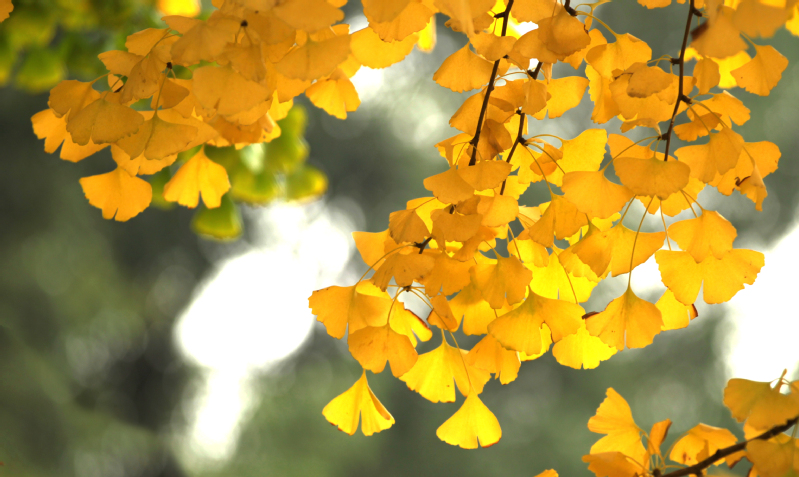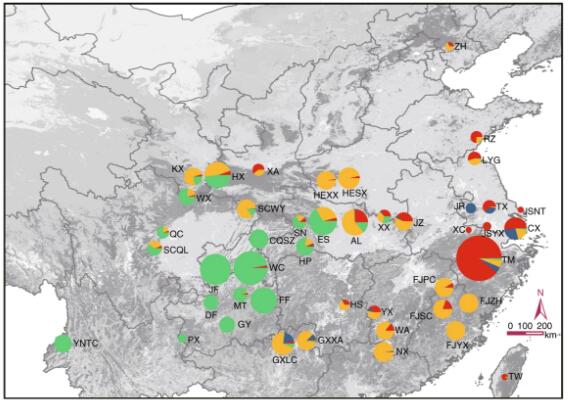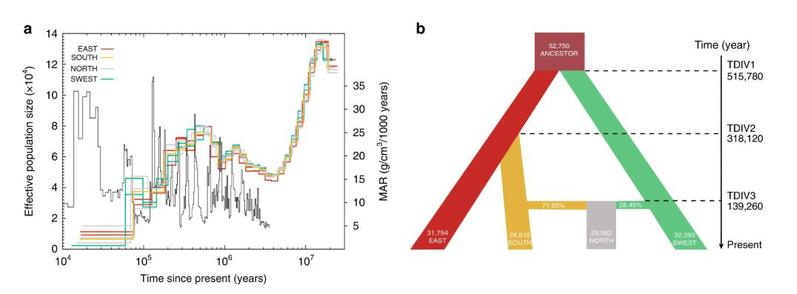
Ginkgo is one of the oldest existing plant species. Its 270 million years’ history makes people curious that how have they lived through great changes till today and wonder about their future. Through 5 years of cooperation by Zhejiang University, Institute of botany, The Chinese Academy of Sciences and Shenzhen BGI Institute, after completing first genome draft, they re-sequence the genome of 545 ginkgo trees and establish the biggest genetic database of ginkgo, providing important information for studying evolution history and potential of ginkgo.
Ginkgo is widely planted throughout the world and is one of the most loved plant species. However, loneliness is a character hardly known by the public. “Modern ginkgo is the only survivor in the old family,” said associate professor Zhao Yunpeng from College of Life Sciences.
The fossils discovered showed that ginkgo used to be prosperous in dinosaurs’ time, when there are many types of Genus and Species, and they distributed across the globe. 100 million years ago, flowering plants became prosperous and ginkgo family declined. G. cranii had the closet genetic relationship with modern ginkgo, it became an individual species 56 million years ago and has died out.
In ginkgo class, one of the four classes in gymnosperm phylum, only ginkgo species survived. Yet it faithfully preserves its ancestors’ appearance millions of years ago. Darwin regarded it “platypus” of the plant kingdom. It is also regarded as “living fossil” by the academic circle.
There are two pending questions concerning the “living fossil” of ginkgo. First, wild population still exist and where? Second, has ginkgo been caught in the vortex of extinction in evolution?
To answer the above questions, shelter is a prerequisite for the existence of wild population. Species have experienced extinction and decline in great amount when the earth went through extreme climates, especially in the ice age. Valleys with complicated landform might have become “shelter” for remaining forests and lucky species within. Species gradually hid themselves here and after climate turned better, they would once again develop themselves outward.
From 2014, the 3 research teams started cooperation and focused on 545 representative ginkgo samples collected from different parts of the world, whose diameters at breast height are all over 50 centimeters (trees whose diameters at breast height are 100 years’ old). They came from China, Korea, Japan, North America and Europe. The samples came from almost all nature distribution already known and all famous Species, boosting the vastest range of collection ever since, said co-first author, Yin Pingping, a graduate student from ZJU.

Collection spot in China and genetic constitution analysis
Through population genetic structures and dynamic historic modeling analysis, the research teams are sure that 4 old genetic constitution of ginkgo exist at 3 shelters in China: Eastern (represented by Mt. Tianmu in Zhejiang Province), Southwestern (represented by Wuchuan in Guizhou Province and Mt. Jinfo in Chongqing) and Southern (represented Nanxiong in Guangdong Province and Xingan in Guangxi Province). Besides, ginkgo distributed in Ta-pa Mountains and Dahong Mountain in Hubei Province are mixed population by southern and southwestern populations during the ice age.
Prof. Fu Chengxin, the leader of ZJU research team said that the shelters have preserved families of ginkgo still existing nowadays. In multiple ice ages at the end of Pleistocene (510 thousand to 140 thousand years ago). Differentiation happened among populations from different shelters with their genetic constitution carried.

Dynamic history of ginkgo population
The research further indicates that ginkgo from around the world almost originated from Eastern China population represented by Mt. Tianmu Population of Zhejiang Province. Ginkgo first migrated to Japan and Korea, then from Eastern China directly to Europe and America,” introduced Zhao Yunpeng.” Analysis of genetic constitution told us that the genetic constitution from Europe is more similar to Mt. Tianmu ginkgo than to Japanese ginkgo.
The famous botanist Peter Crane used to name ginkgo as “the precious gift China sent to the world” <Ginkgo: The Tree That Time Forgot>. Today, it has stronger scientific proof.
The other question about ginkgo is that if ginkgo has entered the end of evolution, we don’t have to give special protection to it as endangered species on purpose. Zhou Zhiyan, a famous paleontologist and Academician of the Chinese Academy of Sciences, once said that although ginkgo still exist, it in fact entered the winter of evolution. He sadly said that diversity of Ginkgo Class has been decreasing, a phenomenon accompanying this is declining population and limiting distribution.
However, in this research, scientists found that ginkgo has maintained comparatively active heritable variation at species level.” Although the biological diversity is extremely low at Family and Genus levels, but ginkgo, as a species, has enough potential to adapt to the environment, and is not in the crisis of extinction,” said Zhao Yunpeng. Comparatively high heritable variation and adaptive gene found recovered after population declines because of multiple ice ages. Ginkgo might have many potential distributions in ice ages and inter glacial periods, which gives it multiple plans when facing with environment mutation. We believe that ginkgo is still evolving, at least it won’t die out very soon. It may develop and reproduce the glory of the ginkgo family.
But we can’t treat ginkgo lightly, because new crisis is emerging. Zhao Yunpeng said that when they conducted field monitoring. Almost no nature-regenerated saplings or surviving seedlings has been found in 10 years.” We think it’s probably because comparatively high canopy density has made setting percentage and survival rates of saplings decrease. In the meantime, animals including squirrels eat seeds, which further decrease the amount of seeds, causing the interruption to generations. The situation urges us to deliver our help to provide precise and emphasized protection,” said Zhao Yunpeng.
The other crisis is that wildest populations are not in nature reserves. Ecological damages and transplants have posed severe threat. This reminds us the famous architect and designer Frank Lloyd Wright, who bought a piece of land in the suburb of Chicago for his house and studio. There’s a ginkgo sapling, Mr. Wright didn’t chop it down. Instead, he designed and built his house and studio around the sapling, which has grown into a big tree and become a spot people would never skip when they visit the place.
To ensure life ad growth in nature for ginkgo, we need more wisdom and love.
(From ZJU NEWSROOM)

